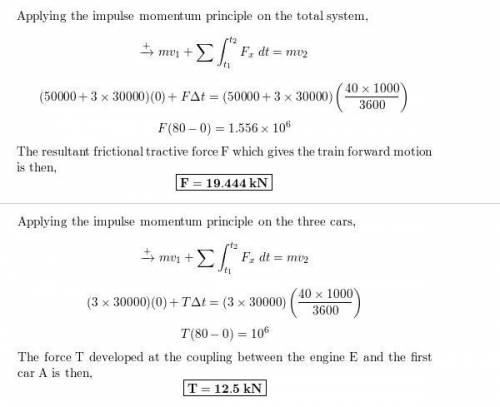
Engineering, 06.03.2020 19:33 Jhertz
A train consists of a 50-Mg engine and three cars, each having a mass of 30 Mg. If it takes 80 s for the train to increase its speed uniformly to 40 km>h, starting from rest, determine the force T developed at the coupling between the engine E and the first car A. The wheels of the engine provide a resultant frictional tractive force F which gives the train forward motion, whereas the car wheels roll freely. Also, determine F acting on the engine wheels.

Answers: 3


Another question on Engineering

Engineering, 04.07.2019 18:10
What are the two (02) benefits, which may result from a successful implementation of preventive maintenance (pm) program in an organization? (clo3)a)- lean manufacturing b)-overlapping responsibilities c)-the planner is not qualified d)-accurate contractor information e)-reduction in equipment redundancies f)-accurate stores information
Answers: 3

Engineering, 04.07.2019 18:20
Atank with constant volume contains 2.27 kg of a mixture of water phases (liquid-vapor). in the initial state the temperature and the quality are 127 °c and 0.6, respectively. the mixture is heated until the temperature of 160 oc is reached. illustrate the process in a t-v diagram. then, determine (1) the mass of the vapor in kg at the initial state, (2) the final pressure in kpa.
Answers: 3

Engineering, 04.07.2019 18:20
For each of the following process: a) sketch the p-v diagram, b)sketch t-s diagram, c) sketch t-v diagram, d) sketch the boundary work on one of the diagrams (a, b or c) and e) sketch the reversible heat transfer on one of the diagrams (a, b or c): 1- isobaric process from compressed liquid to superheated vapor 2- isothermal process from compressed liquid to superheated vapor 3- isentropic process from compressed liquid to superheated vapor
Answers: 3

Engineering, 04.07.2019 19:20
Air enters a horizontal, constant-diameter heating duct operating at steady state at 290 k, 1 bar, with a volumetric flow rate of 0.25 m°/s, and exits at 325 k, 0.95 bar. the flow area is 0.04 m2. assuming the ideal gas model with k = 1.4 for the air, determine (a) the velocity at the inlet and exit, each in m/s, and (c) the rate of heat transfer, in kw flow rate, in kg/s, (b) the mass kg 0.3
Answers: 2
You know the right answer?
A train consists of a 50-Mg engine and three cars, each having a mass of 30 Mg. If it takes 80 s for...
Questions

English, 10.03.2021 14:00


Mathematics, 10.03.2021 14:00




Mathematics, 10.03.2021 14:00

Biology, 10.03.2021 14:00

Mathematics, 10.03.2021 14:00

Mathematics, 10.03.2021 14:00

Mathematics, 10.03.2021 14:00



Mathematics, 10.03.2021 14:00



History, 10.03.2021 14:00


Mathematics, 10.03.2021 14:00




